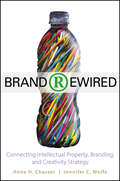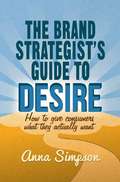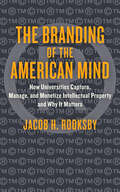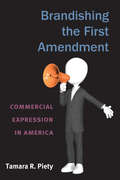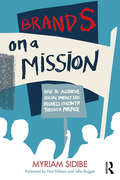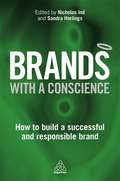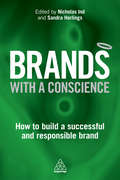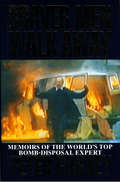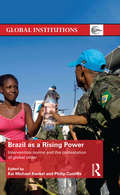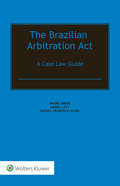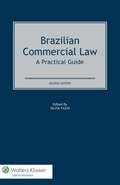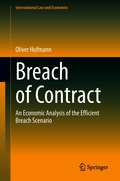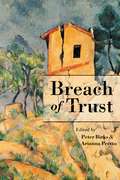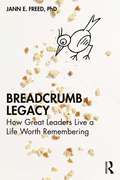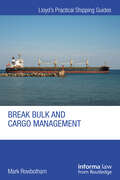- Table View
- List View
Brand Rewired: Connecting Branding, Creativity, and Intellectual Property Strategy
by Anne H. Chasser Jennifer C. WolfeDiscover how the world's leading companies have added value to their company by rewiring the brand creation process Brand Rewired showcases the world's leading companies in branding and how they have added value to their company by rewiring the brand creation process to intersect strategic thinking about intellectual property without stifling creativity. Features interviews with executives from leading worldwide companies including: Kodak, Yahoo, Kraft, J.Walter Thompson, Kimberly Clark, Scripps Networks Interactive, the Kroger Company, GE, Procter & Gamble, LPK, Northlich and more Highlights how to maximize return on investment in creating a powerful brand and intellectual property portfolio that can be leveraged economically for many years to come Reveals how to reduce costs in the brand creation and legal process Illustrates how a brand strategy intersecting with an equally powerful intellectual property strategy produces a greater economic return and more rewards for the brand project leaders Innovative in its approach, Brand Rewired shows you how how leading companies are abandoning the old school research-and-development-driven innovation philosophy and evolving to a Brand Rewired approach of innovating at the consumer level, using multi-disciplinary teams to build a powerful brand and intellectual asset to maximize return on investment.
Brand Rewired: Connecting Branding, Creativity, and Intellectual Property Strategy
by Anne H. Chasser Jennifer C. WolfeDiscover how the world's leading companies have added value to their company by rewiring the brand creation process Brand Rewired showcases the world's leading companies in branding and how they have added value to their company by rewiring the brand creation process to intersect strategic thinking about intellectual property without stifling creativity. Features interviews with executives from leading worldwide companies including: Kodak, Yahoo, Kraft, J.Walter Thompson, Kimberly Clark, Scripps Networks Interactive, the Kroger Company, GE, Procter & Gamble, LPK, Northlich and more Highlights how to maximize return on investment in creating a powerful brand and intellectual property portfolio that can be leveraged economically for many years to come Reveals how to reduce costs in the brand creation and legal process Illustrates how a brand strategy intersecting with an equally powerful intellectual property strategy produces a greater economic return and more rewards for the brand project leaders Innovative in its approach, Brand Rewired shows you how how leading companies are abandoning the old school research-and-development-driven innovation philosophy and evolving to a Brand Rewired approach of innovating at the consumer level, using multi-disciplinary teams to build a powerful brand and intellectual asset to maximize return on investment.
The Brand Strategist's Guide to Desire: How to give consumers what they actually want
by A. SimpsonThis is a guide to help brand strategists consider what people really want in order to enhance their lives, and think about the role of their brand in responding to these desires. It offers a new framework for understanding desire, based on some of the things that are really important to us: our family, friends and community; the desire to explore, learn and grow; how we experience the world through our senses; our appetite to live life to the full; and what we set out to achieve. Brand strategists are the link between a commercial proposition and the lives it means to touch. They can talk to the people the company wants to reach, and – more importantly – listen to them. A brand which both enhances people’s lives, and nurtures the resources on which they depend, will prove more resilient, win trust and achieve better results.
The Branding of the American Mind: How Universities Capture, Manage, and Monetize Intellectual Property and Why It Matters (Critical University Studies)
by Jacob H. RooksbyUniversities generate an enormous amount of intellectual property, including copyrights, trademarks, patents, Internet domain names, and even trade secrets. Until recently, universities often ceded ownership of this property to the faculty member or student who created or discovered it in the course of their research. Increasingly, though, universities have become protective of this property, claiming it for their own use and licensing it as a revenue source instead of allowing it to remain in the public sphere. Many universities now behave like private corporations, suing to protect trademarked sports logos, patents, and name brands.Yet how can private rights accumulation and enforcement further the public interest in higher education? What is to be gained and lost as institutions become more guarded and contentious in their orientation toward intellectual property? In this pioneering book, law professor Jacob H. Rooksby uses a mixture of qualitative, quantitative, and legal research methods to grapple with those central questions, exposing and critiquing the industry;€™s unquestioned and growing embrace of intellectual property from the perspective of research in law, higher education, and the social sciences.While knowledge creation and dissemination have a long history in higher education, using intellectual property as a vehicle for rights staking and enforcement is a relatively new and, as Rooksby argues, dangerous phenomenon for the sector. The Branding of the American Mind points to higher education;€™s love affair with intellectual property itself, in all its dimensions, including newer forms that are less tied to scholarly output. The result is an unwelcome assault on the public;€™s interest in higher education. Presuming no background knowledge of intellectual property, and ending with a call to action, The Branding of the American Mind explores applicable laws, legal regimes, and precedent in plain English, making the book appealing to anyone concerned for the future of higher education.
The Branding of the American Mind: How Universities Capture, Manage, and Monetize Intellectual Property and Why It Matters (Critical University Studies)
by Jacob H. RooksbyUniversities generate an enormous amount of intellectual property, including copyrights, trademarks, patents, Internet domain names, and even trade secrets. Until recently, universities often ceded ownership of this property to the faculty member or student who created or discovered it in the course of their research. Increasingly, though, universities have become protective of this property, claiming it for their own use and licensing it as a revenue source instead of allowing it to remain in the public sphere. Many universities now behave like private corporations, suing to protect trademarked sports logos, patents, and name brands.Yet how can private rights accumulation and enforcement further the public interest in higher education? What is to be gained and lost as institutions become more guarded and contentious in their orientation toward intellectual property? In this pioneering book, law professor Jacob H. Rooksby uses a mixture of qualitative, quantitative, and legal research methods to grapple with those central questions, exposing and critiquing the industry;€™s unquestioned and growing embrace of intellectual property from the perspective of research in law, higher education, and the social sciences.While knowledge creation and dissemination have a long history in higher education, using intellectual property as a vehicle for rights staking and enforcement is a relatively new and, as Rooksby argues, dangerous phenomenon for the sector. The Branding of the American Mind points to higher education;€™s love affair with intellectual property itself, in all its dimensions, including newer forms that are less tied to scholarly output. The result is an unwelcome assault on the public;€™s interest in higher education. Presuming no background knowledge of intellectual property, and ending with a call to action, The Branding of the American Mind explores applicable laws, legal regimes, and precedent in plain English, making the book appealing to anyone concerned for the future of higher education.
Brandishing the First Amendment: Commercial Expression in America
by Tamara PietyTamara R. Piety argues that increasingly expansive First Amendment protections for commercial speech imperil public health, safety, and welfare; the reliability of commercial and consumer information; the stability of financial markets; and the global environment. Using evidence from public relations and marketing, behavioral economics, psychology, and cognitive studies, she shows how overly permissive extensions of protections to commercial expression limit governmental power to address a broad range of public policy issues.
Brands on a Mission: How to Achieve Social Impact and Business Growth Through Purpose
by Myriam SidibeBrands on a Mission explores the importance of creating a performance culture that is built on driving impact through purpose, and the type of talent required to drive these transformational changes within companies – from CEO to brand developers. Using evidence from interviews and stories from over 100 CEOs, thought leaders and brand managers, the book presents an emergent model that organisations can follow to build purpose into their growth strategy – and shows how to bridge the gap between Brand Say and Brand Do. Readers will learn from the real experts in the field: how Paul Polman, former CEO of Unilever, built purpose into the DNA of his company; what keeps Alan Jope (new CEO, Unilever) and Emmanuel Faber (CEO, Danone) awake at night; and how brand developers from Durex, Dove, Discovery and LIXIL have made choices and the reasons behind them. In this book you will learn how a soap brand Lifebuoy taught one billion people about hygiene, how a beer is tackling gender-based violence, and how a toothpaste is tackling school absenteeism amongst many others. Renowned experts like Peter Piot (Director, London School of Health and Tropical Medicine), Michael Porter (Professor, Harvard School of Business), Jane Nelson (Director, Corporate Responsibility Initiative, Harvard Kennedy School) and Susie Orbach (leading feminist and formerly professor, London School of Economics) also share examples, data and their everyday experiences of helping corporates create a culture of purpose. And leading NGOs and UN experts like Lawrence Haddad (Executive Director, GAIN) and Natalia Kanem (Executive Director of UNFPA) will recount how the public and private sector have worked together to create an accelerated path to reaching the Sustainable Development Goals by 2030. The book provides a clear pathway of how to take brands through the journey of developing impactful social missions and driving business growth, and is an essential guide for both managers and students alike.
Brands on a Mission: How to Achieve Social Impact and Business Growth Through Purpose
by Myriam SidibeBrands on a Mission explores the importance of creating a performance culture that is built on driving impact through purpose, and the type of talent required to drive these transformational changes within companies – from CEO to brand developers. Using evidence from interviews and stories from over 100 CEOs, thought leaders and brand managers, the book presents an emergent model that organisations can follow to build purpose into their growth strategy – and shows how to bridge the gap between Brand Say and Brand Do. Readers will learn from the real experts in the field: how Paul Polman, former CEO of Unilever, built purpose into the DNA of his company; what keeps Alan Jope (new CEO, Unilever) and Emmanuel Faber (CEO, Danone) awake at night; and how brand developers from Durex, Dove, Discovery and LIXIL have made choices and the reasons behind them. In this book you will learn how a soap brand Lifebuoy taught one billion people about hygiene, how a beer is tackling gender-based violence, and how a toothpaste is tackling school absenteeism amongst many others. Renowned experts like Peter Piot (Director, London School of Health and Tropical Medicine), Michael Porter (Professor, Harvard School of Business), Jane Nelson (Director, Corporate Responsibility Initiative, Harvard Kennedy School) and Susie Orbach (leading feminist and formerly professor, London School of Economics) also share examples, data and their everyday experiences of helping corporates create a culture of purpose. And leading NGOs and UN experts like Lawrence Haddad (Executive Director, GAIN) and Natalia Kanem (Executive Director of UNFPA) will recount how the public and private sector have worked together to create an accelerated path to reaching the Sustainable Development Goals by 2030. The book provides a clear pathway of how to take brands through the journey of developing impactful social missions and driving business growth, and is an essential guide for both managers and students alike.
Brands With A Conscience: How To Build A Successful And Socially Responsible Brand (PDF)
by Nicholas Ind Sandra HorlingsThe definitive expert guide to ethical brand practice from the prestigious Medinge Group, Brands with a Conscience dissects the philosophies underpinning sustainable brands to arrive at a set of eight clear guiding attributes which can be used as the foundation of a strategy for responsible growth. These attributes span the public persona of an organization, the actions to take when things go wrong, the effort invested in developing relationships, the promotion of core values and balancing measures of success across economic, human, social and environmental factors. They are then used as the criteria to assess twelve carefully selected case studies, which include Dilmah Tea, H&M, Dr. Hauschka, Merci and the John Lewis Partnership, amongst other leading international brands. Because the potential to have bad practice unmasked or to have successes amplified online is greater than ever, it pays to adopt a strategy that builds customer loyalty and trust. Brands with a Conscience inspires via examples of brands which not only exhibit a genuine desire to operate ethically, but also have seen impressive success in terms of engagement with consumers, reputation, and return on investment. The book includes a range of practical tools to bring together the main concepts in an easy-to-adopt framework for building a brand strategy based upon real world experience. If you are a brand manager or marketing professional seeking a conscientious approach to consumer engagement, then Brands with a Conscience will support you every step of the way. 9780749475444 9780749475451
Brands With A Conscience: How To Build A Successful And Responsible Brand
by Nicholas Ind Sandra HorlingsThe definitive expert guide to ethical brand practice from the prestigious Medinge Group, Brands with a Conscience dissects the philosophies underpinning sustainable brands to arrive at a set of eight clear guiding attributes which can be used as the foundation of a strategy for responsible growth. These attributes span the public persona of an organization, the actions to take when things go wrong, the effort invested in developing relationships, the promotion of core values and balancing measures of success across economic, human, social and environmental factors. They are then used as the criteria to assess twelve carefully selected case studies, which include Dilmah Tea, H&M, Dr. Hauschka, Merci and the John Lewis Partnership, amongst other leading international brands. Because the potential to have bad practice unmasked or to have successes amplified online is greater than ever, it pays to adopt a strategy that builds customer loyalty and trust. Brands with a Conscience inspires via examples of brands which not only exhibit a genuine desire to operate ethically, but also have seen impressive success in terms of engagement with consumers, reputation, and return on investment. The book includes a range of practical tools to bring together the main concepts in an easy-to-adopt framework for building a brand strategy based upon real world experience. If you are a brand manager or marketing professional seeking a conscientious approach to consumer engagement, then Brands with a Conscience will support you every step of the way. 9780749475451 9780749475444
Brandschutztechnische Anforderungen an Bauteile: Mit Tabellen nach DIN 4102 und DIN EN 13501
by Anna Maria von HippelDas Bauordnungsrecht ist Landesrecht. 16 Landesbauordnungen sind in Deutschland nötig, um die brandschutztechnischen Anforderungen an Bauteile in dem Bundesgebiet zu regeln.Dieses Nachschlagewerk gibt eine Übersicht über die geltenden bauaufsichtlichen Anforderungen an Bauteile und verweist auf die gesetzlichen Fundstellen. Die bauaufsichtlichen Anforderungen werden in Tabellen zusammengestellt und nach DIN 4102 und DIN EN 13501 angegeben. Das Fachbuch gliedert sich in 3 Abschnitte. Im ersten Abschnitt werden Grundlagen dargestellt und Aufbau und Handhabung des Werks erläutert. Im zweiten Abschnitt wir ein bauteilbezogener und im dritten Abschnitt ein bundeslandbezogener Vergleich der bauaufsichtlichen Anforderungen an Bauteile dargestellt. Die Tabellensammlung im dritten Abschnitt schließt mit einer Synopse der gesetzlichen Fundstellen in den 16 Landesbauordnungen und der Musterbauordnung (MBO) ab.
Braver Men Walk Away
by Peter GurneyFirst published in 1993 and now available as an ebook. The bestselling story of one man’s fight against terrorism.
Brazil As A Rising Power: Intervention Norms And The Contestation Of Global Order (Global Institutions Ser. (PDF))
by Philip Cunliffe Kai Michael KenkelThis book examines the normative tensions inherent in upward mobility within the international system, focusing particularly on the clash between sovereign self-interest and the putatively universal norms associated with international interventions. It provides extensive detail and deep analysis of Brazil’s nature as a rising power, and that nature’s implications for how the country crafts its international profile on issues such as intervention. In addition, the book proposes innovative ways of (re)organising thematic, conceptual and empirical research on the normative behaviour of emergent powers with regard to institutions of global governance and questions of intervention. In analysing what distinguishes Brazil as a rising power, the contributors begin from the assumption that participation in intervention is an increasingly crucial element in demonstrating the capacity and responsibility for which demand accrues as a state seeks increased international profile. As such, the debates around intervention serve as an indicative locus for examining the clash of norms that accompanies emergence as a global player. The book’s approach is to organise the analysis around thematic rather than chronological or praxis-based lines, using the Brazilian case as an illustrative example capable of extrapolation to other emerging powers such as Turkey, India and others. This work draws together rich empirical detail with sophisticated and varied conceptual analysis and will be of interest to scholars of international relations, Latin-American politics and global governance.
Brazil As A Rising Power: Intervention Norms And The Contestation Of Global Order (Global Institutions Ser. (PDF))
by Philip Cunliffe Kai Michael KenkelThis book examines the normative tensions inherent in upward mobility within the international system, focusing particularly on the clash between sovereign self-interest and the putatively universal norms associated with international interventions. It provides extensive detail and deep analysis of Brazil’s nature as a rising power, and that nature’s implications for how the country crafts its international profile on issues such as intervention. In addition, the book proposes innovative ways of (re)organising thematic, conceptual and empirical research on the normative behaviour of emergent powers with regard to institutions of global governance and questions of intervention. In analysing what distinguishes Brazil as a rising power, the contributors begin from the assumption that participation in intervention is an increasingly crucial element in demonstrating the capacity and responsibility for which demand accrues as a state seeks increased international profile. As such, the debates around intervention serve as an indicative locus for examining the clash of norms that accompanies emergence as a global player. The book’s approach is to organise the analysis around thematic rather than chronological or praxis-based lines, using the Brazilian case as an illustrative example capable of extrapolation to other emerging powers such as Turkey, India and others. This work draws together rich empirical detail with sophisticated and varied conceptual analysis and will be of interest to scholars of international relations, Latin-American politics and global governance.
Brazil under Construction: Fiction and Public Works (New Directions in Latino American Cultures)
by S. BealBrazil under Construction tracks how Brazil's major public works projects and the fiction surrounding them mark a twofold construction of the nation: the functional construction of the country's public infrastructure and the symbolic construction of nationhood.
The Brazilian Amazon: Politics, Science and International Relations in the History of the Forest (World Forests #21)
by Joana BezerraThe aim of this book is to analyse the current development scenario in the Amazon, using Terra Preta de Índio as a case study. To do so it is necessary to go back in time, both in the national and international sphere, through the second half of the last century to analyse its trajectory. It will be equally important analyse the current issues regarding the Amazon – sustainable development and climate change – and how they still reproduce some of the problems that marked the history of the forest, such as the absence of Amazonian dark earths as a relevant theme to the Amazon.In a world in which the environment gains each time more space in the national and international political agenda, the Amazon stands out. Known around the world for its richness, the South-American forest is the target of different visions, often contradictory ones, and it plays with everyone’s imagination. This is where the terra preta de índio – Amazonian Dark Earths - are found, a fertile soil horizon with high concentrations of carbon with anthropic origins, which has generated great interest from the scientific community. Studies on these soils and their so singular characteristics have triggered crucial discussions on the past, present and the future of the entire Amazon region. Despite its singular characteristics, the importance of Amazonian Dark Earths – and a history of a more productive and populated Amazon – was hidden since its discovery around 1880 until 1980, when it is possible to identify the beginning of an increase in the number of research on these soil horizons. These hundred years between the first records and the beginning of the increase in the interest around these soils witnessed structural changes both in the national arena, with the military dictatorship and a change in the place of the Amazon within internal affairs, and in the international arena with changes that reshaped the role of the environment in the political and scientific agendas and the role of Brazil in the global context.
The Brazilian Arbitration Act: A Case Law Guide
by André Abbud Daniel Levy Rafael Francisco AlvesBrazil has risen to extraordinary prominence as an arbitration seat, and Brazilian law in matters of domestic and international arbitration has been watched all over the world due to its arbitration-friendly legislation and cutting-edge case law. This is the first book to fully recognize and elucidate this phenomenon with a detailed article-by-article examination, in English, of decisions of the Brazilian Supreme Court (STF) and the Brazilian Superior Court of Justice (STJ) on each of the Brazilian Arbitration Act’s (BAA) provisions. More than two hundred judicial decisions are directly quoted. In-depth annotation of the text of each article includes the following: a short descriptive summary of how the article is interpreted by case law and doctrine; a thorough report of decisions of the Brazilian superior courts since the 1996 enactment of the BAA referring to that article, presenting not only the majority view but also dissenting opinions; and a list of authorities interpreting each article and its relevant case law. All decisions that could represent current case law on arbitration are considered. Nearly half of the quoted decisions have direct impact on international arbitration, and many deal with enforcement of arbitral awards. Therefore, the book will attract not only Brazilian practitioners but will be particularly useful to international counsel and arbitrators dealing with Brazilian parties or cases with a Brazilian element. The only book of its kind, it will prove indispensable for arbitration scholars and law libraries. "By providing a careful and comprehensive compilation of Brazilian case law on arbitration, with a particular focus on the Superior Court of Justice’s leading precedents, this volume makes a valuable contribution to the continued development of arbitration in Brazil and elsewhere. While it will no doubt be of great use to the Brazilian bar, it is a particularly useful reference for the non-Brazilian practitioner and scholar, who do not have ready access to Brazilian court decisions or, in many cases, even knowledge of the Portuguese language". From the foreword by Donald Francis Donovan
Brazilian Commercial Law: A Practical Guide
by Silvia FazioBrazil's power to attract international investors has become irresistible. Large-scale economic development, massive infrastructure projects, substantial agribusiness and commodities markets, and newly discovered oil and natural gas resources-combined with improvements in social standards and a consolidation of democratic institutions-have spearheaded the emergence of Brazil as a formidable global economy challenging the developed nations. This is the first book in English to provide a detailed guide to the ways into and around the Brazilian economy. Thirty seven leading Brazilian practitioners describe and interpret laws and regulations governing business set-up procedures, transactions, contracts, financing, taxation, securities, intellectual property, real estate, dispute resolution, environmental protection, labor, insolvency, competition, trade remedies, anti-corruption, private funds and insurance. They explore every issue likely to be important to investors, including the following: • competition, mergers and acquisitions, joint ventures; • contractual clauses, statutory requirements on specific agreements; • tax incentives available for infrastructure projects; • listing and offering requirements in capital and securities markets; • licensing, franchising, and other intellectual property agreements; • civil proceedings, arbitration, and the mechanisms of dispute resolution; • the structure of the Brazilian judiciary system; • rules on conflicts of law and competence of jurisdiction; • real property acquisition and development; • environmental liabilities; • forms of employment and employment contracts; • insolvency and bankruptcy proceedings; • trade remedy system; • anti-corruption legislation; • private equity, venture capital and investment funds; and • insurance and re-insurance. Taking the point of view of a commercial lawyer required to draft and negotiate agreements governed by Brazilian law, each author contributes particular expertise to this incomparable resource for potential and actual investors in Brazil and their counsel. Thoroughly up-to-date in its exploration and understanding of the legal transformations that are taking place in Brazil, this book will be invaluable to corporate lawyers, investors, academics, and policymakers interested in Brazil's role in the global economy.
Breach of Contract: An Economic Analysis of the Efficient Breach Scenario (International Law and Economics)
by Oliver Hofmann“Efficient breach” is one of the most discussed topics in the literature of law and economics. What remedy incentivizes the parties of a contract to perform contracts if and only if it is efficient? This book provides a new perception based on an in-depth analysis of the impact the market structure, asymmetry of information, and deviations from the rational choice model have, comprehensively. The author compares the two predominant remedies for breach of contract which have been adopted by most jurisdictions and also found access to international conventions like the Convention on Contracts for the International Sale of Goods (CiSG): Specific performance and expectation damages. The book illustrates the complexity such a comparison has under more realistic assumptions. The author shows that no simple answer is possible, but one needs to account for the circumstances. The comparison takes an economic approach to law applying game theory. The game-theoretic models are consistent throughout the entire book which makes it easy for the reader to understand what effects different assumptions about the market structure, the distribution of information, and deviations from the rational choice model have, and how they are intertwined.
Breach of Trust
by Peter Birks Arianna PrettoRecent leading cases have demonstrated the urgent need to modernize the learning on breach of trust,which has lagged behind the flourishing scholarship on the creation of trusts. Since breach of trust or fiduciary duty occupies the centre of the legal stage, it comes as a surprise that, although one or two novelists have chosen 'Breach of Trust' as the title to their book, no lawyer has so far thought it necessary to produce a specialized work on the subject. To fill the gap, this book, written by a team of leading trust lawyers from a number of common law jurisdictions, investigates all the principal aspects of the subject. The nature of the trustee's duties and of the liability for breach is closely examined, and all available defences and excuses are reviewed. Two substantial chapters consider the consequences of assisting a breach or receiving trust property from a trustee acting in breach. The book closes with a critical overview of the entire topic.CONTENTS: 1 Robert Chambers 'Liability for Breach'; 2 Joshua Getzler 'The Duty of Care'; 3 Edwin Simpson 'The Conflict of Interest'; 4 David Fox 'Overreaching'; 5 Lionel Smith 'Property Transferred in Breach'; 6 Charles Mitchell 'Assistance'; 7 Peter Birks 'Receipt'; 8 James Penner 'Exemption clauses'; 9 John Lowry and Rod Edmunds 'Honest and Reasonable Breach' ; 10 Jennifer Payne 'Consent'; 11 William Swadling 'Limitation'; 12 Gary Watt 'Laches, Estoppel and Election'; 13 David Hayton 'An Overview'.
Breach of Trust
by Peter Birks Arianna Pretto-SakmannRecent leading cases have demonstrated the urgent need to modernize the learning on breach of trust,which has lagged behind the flourishing scholarship on the creation of trusts. Since breach of trust or fiduciary duty occupies the centre of the legal stage, it comes as a surprise that, although one or two novelists have chosen 'Breach of Trust' as the title to their book, no lawyer has so far thought it necessary to produce a specialized work on the subject. To fill the gap, this book, written by a team of leading trust lawyers from a number of common law jurisdictions, investigates all the principal aspects of the subject. The nature of the trustee's duties and of the liability for breach is closely examined, and all available defences and excuses are reviewed. Two substantial chapters consider the consequences of assisting a breach or receiving trust property from a trustee acting in breach. The book closes with a critical overview of the entire topic.CONTENTS: 1 Robert Chambers 'Liability for Breach'; 2 Joshua Getzler 'The Duty of Care'; 3 Edwin Simpson 'The Conflict of Interest'; 4 David Fox 'Overreaching'; 5 Lionel Smith 'Property Transferred in Breach'; 6 Charles Mitchell 'Assistance'; 7 Peter Birks 'Receipt'; 8 James Penner 'Exemption clauses'; 9 John Lowry and Rod Edmunds 'Honest and Reasonable Breach' ; 10 Jennifer Payne 'Consent'; 11 William Swadling 'Limitation'; 12 Gary Watt 'Laches, Estoppel and Election'; 13 David Hayton 'An Overview'.
Breadcrumb Legacy: How Great Leaders Live a Life Worth Remembering
by Jann E. FreedLegacy can seem far off and out of reach, but it doesn’t happen at journey’s end and it’s not only for the rich and famous. Legacy is now, and this book shows leaders how you can find and leave meaning on a daily basis. Jann E. Freed, PhD, introduces her Breadcrumb Legacy™ framework, a radical but pragmatic approach, made up of small actions you consciously take over time that accumulate into the trail, or legacy, you’ll leave behind. Breadcrumb Legacy is also a mindset, an awareness of the impact you’re having on your relationships, your organization, and your family, in every communication and interaction. This book is the guide to leaving a trail of meaning throughout your life and career. Based on in-depth interviews, Breadcrumb Legacy provides inspiration and practical stories for living a life worth remembering.
Breadcrumb Legacy: How Great Leaders Live a Life Worth Remembering
by Jann E. FreedLegacy can seem far off and out of reach, but it doesn’t happen at journey’s end and it’s not only for the rich and famous. Legacy is now, and this book shows leaders how you can find and leave meaning on a daily basis. Jann E. Freed, PhD, introduces her Breadcrumb Legacy™ framework, a radical but pragmatic approach, made up of small actions you consciously take over time that accumulate into the trail, or legacy, you’ll leave behind. Breadcrumb Legacy is also a mindset, an awareness of the impact you’re having on your relationships, your organization, and your family, in every communication and interaction. This book is the guide to leaving a trail of meaning throughout your life and career. Based on in-depth interviews, Breadcrumb Legacy provides inspiration and practical stories for living a life worth remembering.
Break Bulk and Cargo Management (Lloyd's Practical Shipping Guides)
by Mark RowbothamThis book covers the subjects of break bulk cargo, general cargo and project cargo, and how these cargoes are shipped. It deals with the cargoes themselves, the vessels used for their carriage, and how the carriage is managed using the process of vessel chartering. Alongside these, it also covers offshore vessel management and how offshore supply vessels are used to carry cargoes to offshore oil and gas installations. Break bulk cargo covers a wide variety of cargoes, from project cargo to more varied cargoes carried on an ad hoc basis, often between ports that are not equipped for container traffic. It also covers the carriage of specific cargoes that cannot fit inside or are unsuitable for containers. This includes the carriage of cargoes for major projects, and cargoes for the offshore sector, which is an area covered in a specific section in the book concerning the use of offshore supply vessels. To date, only minor elements of shipping books cover this kind of trade, hence the need for a new book that specifically covers this subject. The focus of this book is providing expert insights and detailed explanations of the practical issues related to all aspects of break bulk and general cargo management. The book is written for legal practitioners, shipping managers, managers of project cargo, oil and gas companies, shipping professionals, charterers, shipbrokers, shippers and anybody else involved in ad hoc vessel chartering for the carriage of break bulk, general and project cargoes. It will also serve as a valuable resource for students of shipping.
Break Bulk and Cargo Management (Lloyd's Practical Shipping Guides)
by Mark RowbothamThis book covers the subjects of break bulk cargo, general cargo and project cargo, and how these cargoes are shipped. It deals with the cargoes themselves, the vessels used for their carriage, and how the carriage is managed using the process of vessel chartering. Alongside these, it also covers offshore vessel management and how offshore supply vessels are used to carry cargoes to offshore oil and gas installations. Break bulk cargo covers a wide variety of cargoes, from project cargo to more varied cargoes carried on an ad hoc basis, often between ports that are not equipped for container traffic. It also covers the carriage of specific cargoes that cannot fit inside or are unsuitable for containers. This includes the carriage of cargoes for major projects, and cargoes for the offshore sector, which is an area covered in a specific section in the book concerning the use of offshore supply vessels. To date, only minor elements of shipping books cover this kind of trade, hence the need for a new book that specifically covers this subject. The focus of this book is providing expert insights and detailed explanations of the practical issues related to all aspects of break bulk and general cargo management. The book is written for legal practitioners, shipping managers, managers of project cargo, oil and gas companies, shipping professionals, charterers, shipbrokers, shippers and anybody else involved in ad hoc vessel chartering for the carriage of break bulk, general and project cargoes. It will also serve as a valuable resource for students of shipping.
